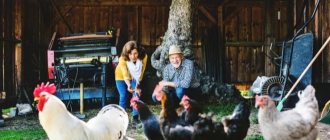Chicken farming has always been popular.
This is not only tasty and healthy eggs, fresh and healthy meat, but also a small profitable business.
Almost everything for keeping poultry can be done with your own hands.
Later in the article we will look at the features of caring for poultry.
We will also tell you in detail how to build a cage and the characteristics of the birds’ diet in such conditions.
Keeping chickens at home: care tips for beginners
Organizing poultry farming at home is not so difficult, the main thing is to properly equip the premises for the birds and take care of a complete diet.
Let's start with the premises:
- Maintaining temperature conditions. The optimal temperature is 23-25°C. In such conditions there will be good egg production. In winter, the temperature should not be below 15°C.
- Ventilation. The room should have vents, but it is better to equip a hood with plugs for such purposes.
- Flooring. Mostly made of wood or adobe. Cover the floor with bedding made of sawdust, straw, hay, etc. In winter, the bedding is compacted to save heat.
Concrete floors are contraindicated; they are cold and increase dampness in the room.
- Accommodation. For every 5 chickens there should be 1 sq. m.
- Lighting. To obtain high egg production when daylight hours are shortened, additional lighting is needed. The day is lengthened only after molting.
- Perches. Should be located a maximum of 1.2 meters from the floor near the window. There is approximately 20 centimeters of perch per individual. The distance between the crossbars is maintained at 50 centimeters.
- Nests. Set up in darkened corners of the chicken coop. One nest is enough for 5-6 individuals. For convenience, use wooden boxes and fill them with shavings, straw, and hay.
- Laz. In addition to the main door to the chicken coop, an additional hole is made so that the chickens can freely go out onto the walking yard.
Feeders. There should be 10-15 centimeters of feeder per individual. It is recommended to place them above the floor, at a low height. Chickens will not rake food.- Drinking bowls. The best option is 5-6 liters. In the summer, the water is changed quite often to avoid attenuation.
- Containers with ash. Chickens are attacked by various parasites. Ash baths will prevent their appearance. In addition, chickens enjoy such baths.
- Cereals. The grain contains small amounts of protein and should be mixed with protein feed. In summer, it is recommended to feed oats, millet, barley - they improve egg production. In winter, to gain weight and save energy - wheat, corn and buckwheat. Cake and meal, beans are a good protein supplement.
- Green food. Contains many vitamins and minerals. It is recommended to give no more than 20% of greens per day, since most of the birds are eaten on the range. When kept without walking, dill, clover, young peas, and alfalfa are introduced into the diet. Nettle is considered the most valuable.
- Roots. It is recommended to add carrots and beets, pumpkin and turnips, and potatoes to the diet. Vegetable crops are boiled and added to wet mash. You can also put table scraps in them.
- Animal feed. Dairy products are given to chickens for full development. Good additives include earthworms, crushed bones, fish and meat and bone meal.
Lifting perches on hinges will make cleaning indoors easier.
For full development and good egg production, chickens should be provided with proper nutrition:
How to maintain optimal temperature?
Despite the chickens’ love for warmth, they also do not tolerate heat well and stop laying eggs.
Therefore, it is important to maintain acceptable temperature conditions not only in winter, but also in hot summer
Winter insulation methods
You need to prepare the chicken coop for wintering in advance, before the onset of the first cold weather. The first step is to try to establish comfortable conditions so that frost and bad weather do not affect the chickens’ lifestyle and their productivity.
Wall insulation
Domestic chickens can catch a cold if they have been walking for a long time in the cold or in strong winds. Drafts and ice-cold drinking water negatively affect them. A favorable temperature can only be achieved by creating a warm, windproof room. It is better to build the walls of the poultry house from thick logs and cover the outside with boards.
Today there are many ways to insulate walls. At the same time, all cracks are sealed, window openings and doors are insulated. The following materials are used as insulation for walls:
- Styrofoam;
- mineral wool;
- expanded polystyrene;
- roofing felt;
- old warm clothes or blankets.
Window openings are insulated using rubber insulation tapes or window putty. The door block is installed on polyurethane foam, and the door itself is sheathed with insulation on the outside and inside, and covered with leatherette on top.
Insulation of ceiling and floor
As a rule, to thermally insulate the floor of the poultry house, it is enough to equip deep litter, which will subsequently turn into compost for fertilizers. To begin with, slaked lime (1 kg per 1 sq. m) is poured onto the floor, then an insulating substance (sawdust, large shavings, chopped reeds, peat, hay, straw, dry moss) is scattered in a layer of 5-8 cm. As soon as the litter is trampled down, it will be reported. By spring, the insulation layer will already be 25-30 cm. To maintain looseness, the litter is turned with a pitchfork from time to time.
The litter performs several functions: maintains temperature, delays the putrefactive decomposition of droppings, and serves as excellent insulation. If the top layer of litter becomes very dirty, it can be replaced with a new one. The ceiling is made of wide beams, which are laid on the walls and secured with forged brackets. The beams are covered on top with boards 40 mm thick.
DIY bird cage
You can build a cage for chickens at home as follows:
- We make a frame. Mostly a metal corner is used, but wood is also suitable.
- For construction you will need vertical posts - 4 pieces, long crossbars - 6 pieces, short crossbars - 6 pieces.
- The crossbars are connected to each other - the frame is ready. For stability, you can add a couple of vertical posts in the middle.
- The height of the compartment is approximately 60 centimeters, width – 2 meters, depth – about 65 centimeters.
- The bottom is made of durable mesh, and a slight slope is made so that the eggs roll into the egg collector.
- The roof and back wall are made of plywood.
- The side walls are installed on hinges, bolts are added - the door is ready.
- Feeders and drinkers are attached outside.
Laying hens
The size of the cage directly depends on the size of the chicken. To make living comfortable, there should be approximately 0.2 square meters per hen. m, stocking density – 5-6 heads.
When kept in cages, laying hens will need artificial lighting for good egg production. It should be distributed evenly throughout the cage room. Very bright light is prohibited so that the bird does not become stressed. Initially, the photoperiod lasts 13 hours, then it can be extended to 17 hours. The increase is made gradually.
Diet of laying hens when kept in cages:
- wheat;
- sunflower cake;
- calcium carbonate;
- vegetable fats;
- vitamins and minerals, salt.
Broilers
The planting density of a broiler in a cage should be 1 square meter. m for 10 heads. For such care, it is better to give preference to cellular batteries.
Basically, broilers are raised for meat. Pursuing this goal, the light regime lasts around the clock for 3 weeks. By the end of cultivation it can be reduced to 17 hours.
Diet of cage-fed broilers:
- crushed and whole grains;
- cellulose;
- fats;
- calcium;
- vitamin complex.
Grain should make up approximately 65% of the total feed. To gain weight, birds are given free access to feeders around the clock.
Feeding
The productivity of egg-laying chickens directly depends on their nutrition. The feeding process is carried out at least twice a day, provided that the chickens have access to grass. It is allowed to feed the poultry with special feed for egg breeds, or you can prepare grain mixtures yourself.
- Stern
- Recipes
- Supplements
Compound feed pk-1
Description of food for egg breeds. Instructions for feeding laying hens Read
Compound feed pk-2 and pk-3
Mineral and vitamin compositions, feeding standards Read
Compound feed pk-4
Used to feed laying hens aged 15-17 weeks Read
Compound feed pk-5
Composition and instructions for feeding broiler chickens Read
Purina Pro
Important differences from the previous line, application patterns Start, Growth, Finish Read
Germination and steaming of barley and wheat for chickens: how to do it correctly and how to give it to laying hens
Wheat for broilers
Rules for feeding broiler chickens with wheat. Dosage for chickens from the second day of life and adult birds Read
Mash
Making mash for broilers at home Read
Rice and buckwheat
How and in what form you can use rice and buckwheat to feed chickens. Standards for adult birds and chickens Read
Bread
What kind of bread can you feed chickens and how to do it correctly Read
Fish
The product is given in limited quantities: overfeeding can cause serious harm to the bird Read
Chalk
Chalk as a food additive for chicken feed. Feeding standards for chickens, young animals and laying hens Read
Meat and bone meal
Meat and bone meal is a mandatory additive for feeding chickens, containing protein and fats of animal origin Read
Fish fat
How to give fish oil to chickens, layers and broilers. What are the benefits of the drug and are there any contraindications Read
Limestone
Limestone (dolomite) flour in the diet of chickens. Advantage over chalk and feed shell Read
Salt
Daily dosage of salt for adult birds and young animals and cases of unwanted use Read
Chickens can eat various mashes with the addition of vegetables and various herbs - dandelion, nettle, plantain, clover, alfalfa, etc. Do not forget about the need for minerals in the diet of laying hens, since they form the shells of eggs. The mineral component is provided by crushed shells and chalk, bone and fish meal.
On average, one chicken eats about 150-160 g of food per day. In the spring, the diet should be richer in whole grains and silage; in the summer it is diluted with fresh greens and grass, crushed grain, and fresh vegetables.
If there is no fresh grass in the walking yard, it is brought from other areas. If there is no access to worms and insects, meat and fish trimmings are added to the chickens' feed to ensure complete nutrition. There should also be small pebbles in the area, which act as “teeth” in the bird’s stomach and help grind large lumps of food.
Shell as a mineral supplement for chickens. What is the benefit, at what age and in what form can it be given? Look
Can broilers be given sand? More details
Chalk as a feed additive for chickens - why is it needed? Read
Feeding chickens with barley: can it be given to broilers? More details
Using whey as a source of animal protein Read
Eggshells in the diet of chickens and chickens. How to give correctly? More details
How to give fish oil to chickens, layers and broilers? Look
Feed tricalcium phosphate for adult chickens, chicks and broilers More
Each breed has its own dietary requirements, which must be taken into account before purchasing young animals. Some breeds are more demanding when it comes to nutrition, while others can be very unpretentious.
Chicken coop
When building a chicken coop, you should follow certain rules:
- place the room on a hill so that it remains dry and warm;
- choose a quiet, calm area; in a noisy environment, the productivity of laying hens decreases;
- there should be no road nearby;
- no closer than 3 meters from a residential building.
A vestibule is required in a chicken coop. In winter, the amount of cold the farmer lets in will be much less.
The poultry house is built with a capacity of 1 sq. m – 4 egg-laying chickens or 3 meat-laying chickens. For example, a chicken coop for 50 birds should have an average size of 15 square meters. m. Nests are built near a wall 6 meters long.
For construction, you can use foam blocks, brick, wood, and shell rock. The chicken coop is equipped with nests, perches, drinkers and feeders, a container for ash, ventilation, lighting, and heaters. It is recommended to insulate the building itself so that the chickens feel comfortable in winter.
Disinfection
It will not be possible to raise productive and healthy livestock without observing sanitary rules in the chicken coop. Carry out cleaning and disinfection as follows:
- They sweep ceilings, walls, and clean perches.
- Change the floor mat.
- If the content is cellular, the metal surface is burned with a blowtorch.
- Surfaces made of stone and concrete are treated with lime (copper sulfate can be added to it to prevent the development of fungal infections).
- The entire chicken coop is sprayed with a disinfectant solution, according to the instructions.
- The room is ventilated.
- Drinkers and feeders are washed.
Ventilation
Special attention should be paid to ventilation. Bird droppings contain harmful ammonia fumes, so access to fresh air is vital for birds.
Ventilation can be done in several ways:
- Install a window, but under no circumstances should you create a draft. The optimal place for a window is under the door.
- A couple of holes are made on the roof, one with a large pipe in it, the other with a smaller one. This option is more suitable for the winter period.
- Installation of ventilation system. This method is more common on poultry farms.
Add a comment Cancel reply
You must be logged in to post a comment.
Request a call from a professional consultant. We will answer all questions, select equipment, and help you save!
All equipment can be purchased in 0% installments without overpayment.
The manufacturer may cancel the warranty for equipment if it is not purchased from an authorized representative.
Are you interested in screw piles for a fence, bathhouse or house? Watch our new video! In this issue we talked with Dmitry Vinogradov, director of the North-Western Pile Structures Plant. He told us a lot of interesting things about screw piles: Is it possible to install screw piles with your own hands? For what purposes is a foundation on screw piles used? Which ones exist?
Manufacturer of septic tanks and storage tanks Termite is expanding its range. Now you can buy: Septic tank Termite Pro 6.5, Septic tank Termite Pro 8.5, Storage tank Termite 6.5, Storage tank Termite 8.5. Septic tanks and Termite storage tanks are made from linear low-density polyethylene (LDL). This material is resistant
At the end of 2018, we installed a heating system for the owner of the popular YouTube channel “House in the Village.” He made a video about this, and in the comments under the video, Maxim’s subscribers asked us many questions about the work performed. It's time to answer them.
As a rule, all work in the garden is carried out until mid-October. But in order to have time to prepare the site for winter, you need to immediately collect late harvests of vegetables. Therefore, they are trying to complete this work by the end of September.
Not all gardeners know that strawberries should be fertilized several times in one season. In this case, special attention should be paid to autumn fertilization to ensure a rich harvest for the next season. It was the preparation of strawberries for winter that experienced agronomists spoke about.
Of all the bird species, chickens are the most popular in many regions. This is due to their unpretentiousness, high reproductive rate, rapid weight gain, immunity to low temperatures, and also the fact that they constantly lay eggs and are a source of dietary meat with excellent taste.
Therefore, poultry is raised not only by residents of the countryside, but also by summer residents who go back to city apartments for the winter. The latter have to cut off the laying birds each time and then buy new ones, which creates not only costs, but also inconvenience. Therefore, experts explained how you can transport chickens to a city apartment for the winter without creating difficulties for neighbors and the owners themselves.
Keeping chickens on the balcony
It should be noted right away that the best place to keep chickens would be a balcony, since birds require ultraviolet radiation and fresh air. Therefore, despite the chickens’ tolerance to low temperatures, it must be glazed. Otherwise, the cells will have to be wrapped in film and additionally heated.
The presence of window frames on the balcony will provide sound insulation, and this is the key to the absence of complaints from neighbors. It is worth noting that chickens are not such noisy birds, but it is still necessary to ensure comfort for people living in neighboring apartments.
Aviaries or cages for chickens
Many people know that keeping chickens outside ensures more active laying of eggs, which are rich in vitamins. But you shouldn’t let chickens roam freely around your balcony or apartment. Therefore, an aviary or cages are suitable as an alternative.
The latter can be made from multilayer plywood, at least half a centimeter thick. But the wood material will need to be coated with drying oil. Each cell should be 70 centimeters high and 60*70 centimeters wide. It is necessary to house two chickens in one cell - this will provide convenience in caring for the birds and cleaning up the droppings. The main thing is not to forget to clean the cages regularly, otherwise the smell will instantly spread throughout the apartment, and then may be heard by neighbors.
Nests for chickens in the apartment
A place for laying eggs can be made from any materials that are at hand. It is also worth remembering that there is a perch for which an ordinary stick is used. It is better to place a separate sheet of plywood under the perch, which will ensure quick removal of droppings. The same goes for cleaning the roost.
Are you interested in screw piles for a fence, bathhouse or house? Watch our new video! In this issue we talked with Dmitry Vinogradov, director of the North-Western Pile Structures Plant. He told us a lot of interesting things about screw piles: Is it possible to install screw piles with your own hands? For what purposes is a foundation on screw piles used? Which ones exist?
Manufacturer of septic tanks and storage tanks Termite is expanding its range. Now you can buy: Septic tank Termite Pro 6.5, Septic tank Termite Pro 8.5, Storage tank Termite 6.5, Storage tank Termite 8.5. Septic tanks and Termite storage tanks are made from linear low-density polyethylene (LDL). This material is resistant
At the end of 2018, we installed a heating system for the owner of the popular YouTube channel “House in the Village.” He made a video about this, and in the comments under the video, Maxim’s subscribers asked us many questions about the work performed. It's time to answer them.
As a rule, all work in the garden is carried out until mid-October. But in order to have time to prepare the site for winter, you need to immediately collect late harvests of vegetables. Therefore, they are trying to complete this work by the end of September.
Not all gardeners know that strawberries should be fertilized several times in one season. In this case, special attention should be paid to autumn fertilization to ensure a rich harvest for the next season. It was the preparation of strawberries for winter that experienced agronomists spoke about.
- Author: Maria Sukhorukikh
Rate this article:
- 5
- 4
- 3
- 2
- 1
(0 votes, average: 0 out of 5)
Share with your friends!
Walk
To properly organize walking, you must adhere to the following recommendations:
- When keeping chickens in a chicken coop, walking is organized. Usually the enclosure is built on the south side.
- To do this, the area is fenced with a net (for example, chain-link).
- For laying hens the height is 2 meters, for meat breeds 1.8 meters is sufficient.
- In the walking yard there are drinkers and feeders, and a container with fine gravel.
The productivity of chickens in the fresh air increases, they lay eggs more often, and the meat is of high quality.
Walking can also be free. Chickens go out for a walk whenever they want and also come back. This method allows the farmer to save on feed, but the garden will be at risk.
Equipment of the place of detention
For summer maintenance, the chicken coop must have two compartments and a walking area attached to it. The chicken coop itself is made as a dense covered room with a door, designed for such a number of chickens that they are allocated 30 cm each on a perch on one level. The perch should be located 60 cm above floor level.
For such a room, part of the utility block, which is always available at the dacha, may be suitable. In addition to the perch, you will need to place nests there, in a secluded place, for laying eggs. A grill can be used to separate the front free part so that the hens can hide from the weather.
Next immediately there is a covered run where the bird spends the whole day. The rain does not get there, and the sun's rays and fresh air pass through the picket fence or chain-link mesh. A feeder and drinking bowl are attached to one wall of the run outside so that there is no fuss when eating food. Water should be in the container at all times, mineral supplements and chalk should be kept in the compartments at all times. The bottom of the feeder with protein food should open and the container should be cleaned so that there are no sour residues in the heat.
The walking area should be on the ground or grass. It’s great if there’s a dried tree left there, the chickens will climb the branches with pleasure. Such a structure with a bottom lined with a layer of sawdust requires almost no maintenance, just sweep away the night's feces in the morning and close the door to the night light from the coolness.
Maintenance in late autumn and winter
Keeping chickens in the country in winter is more difficult. It is necessary to organize ventilation, heating the chicken coop in severe frosts, lighting and provide dry bedding. This is difficult, since the chickens are in cramped conditions, there is a lot of fumes from them, and insects can appear in cramped conditions. Therefore, the best option would be to build an extension to the main bath wall.
In this case, you should create a room that is convenient for maintenance. It is better to make it two-story, then the sleeping place will be located on top, like on a shelf in a bathhouse, and below you can equip a walk with feeders and an ash pan. This will make it convenient to clean up the night guano and create space for the laying hens. It is better to locate nesting sites in a secluded place on a shelf, where the birds feel safer.
Brooders for raising chickens
Chicks that are born are quite sensitive to the environment. Temperature fluctuations, changes in humidity, low lighting, and drafts are unacceptable for them. A brooder will help solve all these problems. Design Features:
- Small dimensions, length – meter, width and height – 0.5 meters.
- Made from dense material to provide thermal insulation. Shouldn't get wet.
- A removable pallet is added to the structure, which is filled with a layer of sand. This will make it easier to change the layer contaminated with droppings.
- Feeders and drinkers are equipped in such a way that chickens cannot turn them over or trample inside.
- 40 or 60 W incandescent lamps are installed.
- The temperature is maintained at about 20-26°C.
Buy laying hens or raise chickens
Bird breeding can begin with the acquisition of adult birds. Young chickens are good because they will immediately begin to lay eggs and delight their owners. But they need to be chosen correctly. It happens that instead of young ones you can buy rejects from the factory.
Buy young stock
It would be better if young animals are purchased from a farm that specializes in poultry breeding. When choosing, you should examine the chicken carefully:
- the feather at the anus should be clean without traces of feces;
- the comb and beard are bright red;
- legs are yellow without growths;
- the feather is dense, smooth, shiny;
- The chicken is mobile and has difficulty getting into the net.
A healthy chicken will quickly begin to lay eggs. It is necessary to ensure that the chickens do not have any external damage to the skin, as their friends will immediately begin to intensively peck at the bleeding area. This is their nature; the weak ones are pecked to death.
Breeding chickens
The best time to purchase a squeaky family will be February or March. Chickens raised at this time produce a full clutch in the summer. Breeding chickens in the country is possible only with a one-year stay. Then the pullets will lay full eggs for a long time. It is profitable to purchase broiler chickens for seasonal residence. During the season you can get a decent amount of first-class dietary meat with intensive feeding. Grass growing in abundance at the dacha at this time will help you save on feed.
The most adaptable and strong chickens are the ones raised by the hen. Depending on her weight, she can warm from 11 to 20 eggs with her warmth and after three weeks fluffy balls will come out. Experienced housewives bribe daily allowances from the factory at the time the chicks are hatched. The chicken does not notice the trick, warms and guides everyone. Less worries for the hostess, the kids are under supervision.
Special food for babies. First, an egg is fed, and then crushed grain mixture, cottage cheese, fish and other protein feeds. The main thing is that the food is always fresh. Free and safe access to water must be ensured at all times. The chickens grow quickly and after two months they no longer need the mother hen.
You can breed chickens in an incubator and become their mother for the first week, providing almost round-the-clock control.
Litter processing
With proper maintenance and proper feeding, chicken droppings are rich in microelements. A large amount of it is a poisonous suspension. Processing chicken manure is an important task that needs the right solution.
The best option is to make compost. To do this, the droppings are mixed with various plant wastes (residues of vegetables and fruits, leaves, weeds), straw, sawdust, peat, shavings. Fresh plants cannot be used for compost.
Keeping chickens at home is not easy, but it is always profitable. As a result, you will not only have food, but also excellent fertilizer for your garden.
Which chickens are suitable for a beginner
Poultry farming is interesting because every day you can see the result - fresh eggs with a bright yolk, fast-growing young animals, additional amount of dietary meat for the table. But how can you breed poultry if you have neither knowledge nor experience in handling it? There is no particular problem here:
- Start with broilers . Try to produce just one batch per season and you will immediately decide whether it is interesting or not, whether you have the desire and opportunity to do this business in the future.
- Next spring, buy young crossbred chickens . This step will require spending money and time on building a chicken coop. Try to immediately build a high-quality room with minimal heat loss in winter. Try keeping the bird there for two or three years. Only after this can you understand for sure whether you need this problem and care in your life.
- If you like birding, you can spend money and buy a dozen purebred chickens with a cockerel at the age of one month . As they grow up, they will get used to you and will delight you with their existence for many years.
- It doesn’t matter whether you have your own farm or are trying to raise poultry in your country house . If you start to succeed, there will always be time and opportunity to do this interesting thing.
Excellent 1
Useful video
Watch the video on the topic:
If you find an error, please select a piece of text and press Ctrl+Enter.
There are not so many people who want to keep a chicken in a city apartment, but such people still exist. The reason for this desire may be both a love for these useful birds and a practical goal, which is constant access to fresh eggs and organic meat. But keeping chickens at home is not an easy task, which is accompanied by many restrictions and features, which we will consider in the article.
Why I decided to have chickens on the balcony
I didn’t delve into the details and all the nuances of keeping chickens on the balcony at that time. First, I needed to somehow digest for myself the very fact of what I saw. Chickens in the city! Until this moment, I would not have even imagined that this was possible in principle. Nonsense! And if someone had told me that within a year I myself would become interested in the topic of keeping chickens at home, I would simply laugh in their face.
But now, a year has passed. It just so happened that I was left without work for some time. I sat at home, counting every penny. Roll it in the refrigerator. It was precisely in those days that the idea came into my head to try to have chickens in my own apartment. At least I won’t die of hunger; there will always be a fresh egg on the table, I reasoned.
In addition, I believed that raising chickens in small quantities is the simplest thing. Actually, nothing is required from you. I fenced off a corner, stocked up on food for my laying hens, and then just do all you can do - collect eggs. If you want, eat them yourself, but if there is a surplus, you can sell them.
Is it possible to keep a chicken in an apartment?
In fact, the question “is it possible to keep a chicken in an apartment?” does not have a clear answer. Today in Russia there is no law that would specifically and clearly regulate the rules for keeping chickens in a city apartment.
But there are some regulations in which you can find a loophole both in favor of keeping laying hens in the house, and as an unequivocal ban on this.
At the moment, a regulation is being developed on the list of animals prohibited for keeping in an apartment. However, the bill has not yet been adopted, the list has not been compiled, and it will mainly focus on wild, aggressive and exotic animals.
But the raising of farm animals is still not clearly regulated by law.
First you need to decide whether the chicken is a pet.
The Federal Law “On the Responsible Treatment of Animals” in Article 4, paragraph 7 defines a pet as “an animal maintained by an owner - an individual, and under his temporary or permanent supervision, cats, dogs, as well as unproductive and wild animals in captivity , not included in the list of animals prohibited for keeping.”
A chicken, even an ornamental breed, is definitely a productive bird because it lays eggs.
Thus, it is hardly possible to talk about the absolutely legal keeping of these birds in a room or on a balcony.
Also, the Federal Law “On the Protection of Animals from Cruelty” states that any pet must be kept in appropriate conditions that correspond to its biological characteristics, satisfy the need for food, water, sleep, walks, vigorous activity, communication with other animals and person.
And the number of animals kept in the apartment must be such that it is possible to maintain the living space in accordance with sanitary and epidemiological standards.
In this regard, we can hardly conclude that chickens in apartment conditions can satisfy all their natural needs. At a minimum, their living space will be very limited, and walking in the fresh air, in their natural habitat, is impossible, even if the laying hens live on the balcony.
So the question of how humane it is for the birds themselves to keep them in the house, according to this law, is quite controversial.
The third law that regulates the keeping of pets is Article 17 of the Housing Code of the Russian Federation.
This article states that “the use of residential premises is carried out taking into account the rights and legitimate interests of citizens living in this residential premises, neighbors, fire safety requirements, sanitary, hygienic, environmental and other legal requirements, as well as in accordance with the rules of use residential premises approved by the federal executive body authorized by the Government of the Russian Federation.”
Thus, raising chickens in a residential apartment building is labor-intensive and difficult to carry out within the laws of the Russian Federation. It is quite difficult to maintain sanitary and hygienic rules with chickens, and neighbors are usually extremely unhappy with such feathered residents because they make a lot of noise.
In practice, we see that some owners, despite all the restrictions, still raise chickens at home.
In most cases, neighbors are very unhappy with this, since roosters begin to crow loudly in the middle of the night, chickens cackle, and the smell from the waste products of birds is quite pungent and unpleasant for city residents.
On the one hand, such noise in the middle of the night violates the rights of residents, but on the other, law enforcement agencies say that the noise ban applies only to those objects and phenomena that are controlled by humans, but noise from both small children and pets does not. is.
Although at this point it is worth returning to the definition of “pets” according to Russian legislation.
Please note that even if your neighbors cannot stop you from raising chickens on your balcony, you will still have to live with their discontent and the scandals that arise from this.
However, practice shows that keeping laying hens in an apartment is still possible. Some inventive owners approach this matter responsibly - so that neighbors may not even be aware of the feathered “pets”.
With the right choice of the breed of birds, their number, sex and living conditions, it is possible to ensure their existence in a way that does not violate the rights of residents of panel houses and complies with sanitary and hygienic standards.
How I built a chicken coop in the corner of the loggia
I didn’t see a problem with allocating a place in the apartment for a mini-chicken coop. I had a fairly spacious glazed loggia, a third of which could have been devoted to useful work.
I immediately imagined how I would partition it with a lattice made of some kind of chain-link mesh, arranging a small door in this partition. Then all that remains is to put a feeder and a bowl of water there, after which you can safely let the chickens into the pen. All I could do was sit in a chair and “smoke bamboo,” waiting for the first eggs from them, as a reward for my righteous labors.
Perhaps it was the fact that this matter from the outside seemed quite simple to me, and pushed me to implement the idea with the chicken coop. I didn’t shelve it. True, I didn’t find chain-link in hardware stores near my house (this is definitely not a popular product for the city), but I did get a roll of wire mesh, the kind that finishing workers usually use when plastering walls.
At the moment when I was already walking around my loggia with a tape measure in my hand to determine which piece of this lattice I should cut off first, I suddenly thought: wouldn’t the amount of space be too large for several chickens? Not the area of the loggia allotted to them, but the space.
I admit, at that moment I thought not so much about the chickens themselves, but about the possibility of somehow saving on their maintenance. Although I had no experience in raising chickens, I still knew some general principles of handling poultry. It’s not for nothing that when I was a child, my parents sent me to my grandmother’s village for summer and winter holidays, and now they themselves keep chickens there!
So, for example, I knew that in winter in village chicken coops they often leave a light bulb on all night, so that at least some heat comes from it. And particularly advanced village poultry farmers even install a special infrared lamp for heating.
In the future, closer to winter, I was also going to get one like this, but even the thought of it was enough for me to draw a logical conclusion - I would have to use it to warm not so much the chickens themselves, but the under-ceiling space of the loggia! After all, heat, according to the laws of physics, rises.
After thinking a little, I decided to reduce the height of the future chicken coop to one meter, providing it with a removable lattice roof. According to my calculations, this option will provide several advantages at once. In winter, for example, you can put glass on it, which will allow you to retain some of the warm air under it.
In addition, a low roof will help solve the lighting problem. After all, city lights literally flood my loggia with light at night, which, as I thought, could disorient the chickens regarding the time of day. I assumed that if I threw a blanket over this makeshift roof at night, the problem with light would be easily solved, and my chickens would get something like a small but cozy bedroom.
The height of the balcony chicken coop should not be too high so as not to heat the air in winter. backyard chickens
Advantages and disadvantages
Keeping chickens in an apartment has its pros and cons.
Advantages of keeping poultry at home:
- this provides owners with constant access to egg products;
- when the egg-laying period ends, the chickens go to meat, which is always preferable to the product from the store;
- you know exactly what the chicken was fed and in what conditions it was kept, and therefore you can be sure of the quality of its products;
- apartment maintenance provides homemade meat and egg products to people who do not have the opportunity to live in a village or town in a private house and own an animal farm;
- psychological function - it is pleasant to take care of birds, they become not only useful, but also beloved family members;
- chickens that are kept at a very young age (about a couple of days from hatching) become very attached to humans, love to spend time with them and even ask to be petted.
However, raising farm birds in the house is not limited to only the advantages, because in urban living conditions they cause a lot of inconvenience:
- it is difficult to find a room suitable for chickens and satisfying all their needs, because something will definitely have to be sacrificed (for example, free range);
- chickens are quite dirty birds, they relieve themselves absolutely uncontrollably and according to their needs, it is impossible to train them to use the toilet, so you need to be prepared that the birds will shit everywhere they go, and all this will have to be constantly cleaned up after them;
- an unpleasant odor, which is difficult to remove, will be present to some extent, even if you meticulously maintain cleanliness;
- increased noise produced not only by roosters, but also by hens who constantly cackle;
- the need for significant expenses to equip a bird house equipped with everything necessary;
- dissatisfaction of neighbors due to bird noise, smell, unsanitary conditions;
- the risk of violating the laws of the Russian Federation, which is fraught with a fine or forced sale of the residential premises if the owner of the birds does not vacate the apartment from them or in the case where behavior towards the birds can be considered cruelty.
How to get eggs from broilers
Broilers are a specially crossed breed of poultry. Chickens of meat (Cornish) and meat and egg (Plymouth rock) breeds are used as parents. During breeding, the best characteristics of the maternal and paternal lines are selected. The resulting hybrids have a special physiology. With proper nutrition, chickens weigh 2 kg at 1.5 months. And at 50-60 days of life they are ready for slaughter. The weight of such a chicken reaches 4-5 kg.
Broilers are not raised at home to produce offspring. Their fate is to quickly gain weight. There are specialized breeds for eggs. Therefore, there is no need to “reinvent the wheel”. Laying eggs by broiler birds will lead to problems: disease and death. Domestic breeders are trying to correct this problem by creating universal crosses.
When can you get your first eggs? The period of puberty in broilers occurs much later than in ordinary laying hens - at 6-8 months. Some individuals begin to lay eggs when they are one year old.
Due to genetic predisposition, eggs have two yolks. They cannot hatch into a living chicken. And if there are any offspring, they die at an early age.
Broiler chickens rarely hatch
At home, broiler chickens most often lose the genetic characteristics of their parents. The offspring are larger than ordinary chickens. They lay few eggs (2-3 per week) and are obese.
But if you decide that you need eggs from this breed of chicken, remember some subtleties.
- Include plenty of greens and shells in your diet. Birds are prone to obesity, so a diet is necessary. Don't allow yourself to overeat.
- There may be problems with the oviduct. Monitor your pets' behavior. If the bird does not eat or drink for several hours, this is a cause for concern. Large egg shape and excess weight will become a problem for the health and life of the bird. Gently massage the abdomen so that the egg can come out.
If desired, you can breed broilers and get large eggs with two yolks from them. However, the profitability of such production is much lower than that of conventional layers. And health problems will overshadow the whole process. As a result, you will lose not only the egg, but also several kilograms of meat.
As professionals note, when broiler chickens reach puberty, the meat loses its distinctive taste. It becomes dry, hard and has an unpleasant aftertaste.
The meat of mature broilers is very tasteless
Popular types for home keeping
Owners who are responsible in choosing birds for home maintenance understand that any type of chicken is not suitable for living in an apartment. Each breed has its own characteristics, differs in temperament, character, and behavior.
And some bird species are better suited to being raised indoors than others: due to their calm temperament, they have no need for increased activity and produce the least noise.
The breeds most suitable for keeping in residential premises include the following.
- Leghorn - these laying hens are able to adapt to any living conditions. They are unpretentious and can adapt well to life on the balcony or in the room. In addition, they are distinguished by early puberty and produce their first eggs at the age of five months. And the number of eggs received during the year can reach 300 pieces.
How to care for chickens
The birds quickly get used to the calm voice of the mistress and the food they receive on time. They are independent, but jealous of signs of attention from the mistress. If you had to take one of the pets in your arms to examine something, then you should pet the rest too.
It is forbidden:
- overfeed chickens;
- disturb during egg laying;
- swear or talk irritably.
Feed base
Chickens are omnivores. They can eat chopped or simply cut root vegetables, minced meat or fish from waste with bones, and green chopped grass. But they cannot do without grain. Therefore, every day 60% of the daily diet should be a mixture of cereals, and preferably wheat. To obtain adequate nutrition, a chicken must peck half a glass of grain per day, and all other feed in the required quantity.
Space, clean feeders, balanced feed and fresh air will create all the conditions for productive maintenance of the herd. Chickens love mash very much. This is fresh, finely chopped nettle, midge, and onion mixed with bran and porridge. It is difficult to overfeed a hen that is laying eggs, and if it is underfed, the clutch is sharply reduced.
A good stimulator for egg production are special additives called premixes. They should be given in microscopic doses. Special chicken feed will reduce the hassle, but will not replace grain mixtures. In winter, all table scraps will become welcome food. Sometimes you can get hold of green food at vegetable stores from entrepreneurs. Winter eggs become incredibly tasty after such feeding.
Keeping chickens at home
- The first thing you need to do before you bring chickens into your home is to decide on their purpose : meat, eggs, companion, or all three. Having determined the purpose of raising birds, choose a breed that best suits this purpose. It is better to choose the calmest, most unpretentious and compact chickens so that they feel comfortable in a limited apartment space.
- The next question is the number of goals . Usually, when keeping chickens in a free range, when arranging a poultry area, it is assumed that at least 1 square meter is required per individual. m of free space. This is impossible at home, so at least assume that birds need about 30-40 cm of space on their perches.
- The fewer chickens there are on the premises, the less work there is to care for them and the less noise and dirt they will produce. A couple of individuals will be enough to periodically delight yourself with completely home-made scrambled eggs.
- Give preference only to laying hens. Roosters are noisy birds: every morning they will emit a piercing vocal trill that will wake not only you and your household, but also all your closest neighbors from bed. In addition, chickens do not need roosters to lay eggs. Its only function is to fertilize eggs for reproduction.
- Having decided on the goals, breeds and number of chickens, think about the room where the birds will live. To do this, you can use one of the rooms or a glazed balcony or loggia.
- An improvised chicken coop should be a well-ventilated room with an exhaust hood or ventilation. At the same time, the air here should not be too dry or too humid.
- If the choice fell on a balcony or loggia, then they must be closed and well insulated so that the chickens do not freeze in the winter. The minimum temperature in winter should not be below +10°C.
- In the summer, it should be possible to create shading on the balcony so that the chickens do not overheat in the sun.
- The birds should always have access to fresh air , but the windows should be protected with mosquito nets to prevent any other wild birds from getting into the company of your chickens.
- To protect your neighbors from excessive noise, take care of soundproofing , especially if you have a rooster in your small flock. Plastic windows are the bare minimum to protect the neighbors’ psyches from constant noise.
- The premises must allow for regular and frequent cleaning and disinfection.
- The “poultry house” must contain all the attributes necessary for chickens - feeders, drinkers, perches and nests .
- Chickens need long daylight hours - at least 11-12 hours. Therefore, it will be necessary to equip the room with additional lighting.
Possible problems and their solutions
Keeping laying hens and broilers in the same coop can cause many problems. After all, breeds can behave aggressively towards each other. Moreover, each of them has an advantage: broilers are superior in weight, and laying hens are superior in terms of activity.
If fights break out between them, there may be losses on both sides. Sometimes chickens are so aggressive that they peck individuals to death. Therefore, if you need to introduce representatives of another breed, you need to do this at night. This way they will spend time together until the morning, which will reduce the risk of fighting between them.
Broiler and laying hens have different daily routines. While the latter are actively walking in the walking area, broilers take their places in the chicken coop.
Therefore, it is better to make baskets and cages for them in the lower part of the room, where other birds will not disturb them.
Sometimes in the morning after opening the coop, a farmer finds dead chickens on the ground.
Since broilers sleep in the lower part, and laying hens on top, a crush may occur, during which some birds die.
Therefore, you need to equip the chicken coop so that the individuals do not interfere with each other. To do this, the lower tiers are deepened and a stepladder is placed along which the hens can climb up.
Fights between roosters of different breeds are often observed. Moreover, they can bite to death. Therefore, you need to either keep only roosters of the same breed for all the chickens, or make different walking areas.
Caring for birds in an apartment
Caring for chickens living in an apartment is a difficult and responsible task.
You need to monitor the temperature and humidity of the air, turn on additional lights, clean, feed the birds, and let them wander around the “chicken coop” so that they can warm up and communicate with each other.
- Feeding chickens should meet the needs of the breed you have chosen, be regular and as rich as possible in proteins, minerals, and vitamins. Laying hens should be fed grain, wet mash, fresh greens and grass, vegetables, and be sure to be given gravel, chalk, and crushed shells.
- Bird cleaning must be done daily, or even better, several times a day, otherwise the room will very quickly begin to smell bad of droppings. In addition, be prepared that during the molting period, feathers from birds will fly in all directions, and cleaning will be needed even more often.
- Once a week, it is necessary to disinfect the room to prevent parasites, fungi, mold and pests from infesting it.
- All leftover food should be removed from feeders, floors and cages immediately after feeding. This is important because, firstly, excess food leads to overfeeding of birds and their obesity, the risk of which increases several times with a sedentary lifestyle, and secondly, food left lying on the floor will attract some of the most dangerous carriers of infections - cockroaches, which, if you get them, will soon spread throughout the whole house, and after that it will be quite difficult to get them out.
- Chickens should have constant access to fresh and clean water.
- The room must be ventilated daily to avoid air stagnation, but at the same time avoid drafts, because birds are very afraid of them.
- If you nevertheless decide to take such a step as keeping laying hens in an apartment, then try to equip the premises as much as possible to suit their needs and characteristics.
As we can see, raising chickens in an apartment or house is a completely feasible activity, but very problematic. Birds are time consuming and require constant care.
In addition, be prepared for the discontent of your neighbors, since keeping farm animals and birds in a residential building violates at least three laws of the Russian Federation.
Problems of shared content and ways to solve them
The main problem when introducing birds to each other is possible fights. Moreover, chickens can peck their relatives until they bleed or cause injury. These troubles reduce the growth of broilers, and laying hens are worse at laying eggs.
- You can reduce the number of fights between birds by increasing the length of the feeders or their number and placing them in different corners of the chicken coop. Then individuals of different species will contact less often.
- It is better to place such violent individuals in separate cages, and place other birds in their place.
- Separately, it is worth noting the keeping of roosters. They should be only one breed, and even better, one rooster for the whole chicken coop.
- If there are several roosters, then they should be separated into different enclosures or walked at different times.
In dense housing conditions, diseases in broilers and laying hens are not uncommon. Infectious diseases are more common due to dampness, low temperature, and drafts.
Symptoms in chickens are:
Treatment is carried out with the drugs Tetramizole, Enroxil, Baycox. The chicken coop is insulated and disinfected.
Diarrhea in broilers occurs due to both colds and salmonellosis and colibacillosis. Sick birds are isolated from the population and treatment is prescribed.
Broiler breeds are more often than others susceptible to leg diseases; when a bird falls out of the blue, an uneven gait appears. The cause of this disease lies in the lack of vitamins and microelements.
Breeds of laying hens
The goal of any business owner is high productivity all year round. To avoid disappointment in breeding laying hens, you need to choose the right breed of bird . She must be in good health to provide eggs and withstand harsh winters well. The following breeds are recognized as the best laying hens.
- Loman Brown
This breed is one of the most popular among Russian breeders. She was appreciated for her high egg production - up to 300 eggs per year. The reproductive system becomes mature by the age of five months, and high rates persist up to 3 years. The breed has strong immunity, the survival rate is 98%. Resistant to diseases and harsh winters. Lays large eggs, reaching 80 g. At the same time, it is possible to save on food - the hen does not eat more than 130 g per day.
The breed was brought from Holland. The chicken weighs two kilograms. She is ready to hatch from 6 months of age; egg production rates increase gradually. The number of eggs laid depends on the color of the bird. Thus, white chickens lay up to 290 eggs per year , while gray or brown birds exceeded this figure by 30 eggs. This is due to the fact that whites are more sensitive to cold, so they expend additional energy to warm themselves, which is reflected in the level of egg production. An egg of this breed weighs from 65 to 80 g and has a strong shell, which is a good indicator for transportation.
Chickens in the country are disturbing the neighbors
You can also buy a dacha and farm for your own pleasure; if you really want to start farming, then it would be best to buy your own house or dacha plot instead of an apartment, and have as many animals as you want, without disturbing anyone.
This is the first opinion, but in fact many neighbors will not like the crowing of a rooster, because people come to their dachas and gardens to relax and sleep in silence. And here your Petka is screaming like a siren.
It’s special if he’s a guy of the Yurlov vocal breed. We need to agree!
Neighbors in the dacha can drink and yell, listen to loud music until 3 am. This is the norm - this is how they rest. But for a live alarm clock at 4 o’clock, this company will tear you to shreds and scatter you around your dacha or garden cooperative.
Look at the photo of a quail in a cage in the kitchen.
In a multi-storey building, of course, you can keep laying hens without a rooster if you really want to, but do you need it? After all, you will have a lot of problems with your neighbors; they will make constant complaints and reproaches. After all, no one likes constant noise and discomfort.
Still, a house with a special place for this is best suited for keeping animals or birds, and then it will be convenient for you and will not cause any discomfort to other people.
Keeping laying hens at home
The above breeds of laying hens were bred specifically for cold climatic conditions . They are unpretentious, but given comfortable conditions and convenient placement, they sharply increase their egg production. Often laying hens are housed together with other domestic animals; in this proximity they feel good. But in accordance with the rules of sanitary and hygienic standards, such a decision is incorrect; they must be placed in a separate poultry house.
Construction of a chicken coop
The premises for chickens should consist of a house and a walking pen , which is attached to it. The area for the construction of the chicken coop is chosen to be dry and draft-free. The house for laying hens is not located in a low-lying area where there is a high risk of flooding. The poultry house is fenced with a fence or mesh, which will help protect the livestock from predators trying to get into their home.
According to the rules for building a chicken coop, the height should not be higher than 1.8 m in order to prevent the temperature from dropping in cold weather: it should not be lower than 15 degrees. The ventilation system is simple - you can use ordinary vents. But a more convenient option may be a hood with the ability to close. It is able to control the flow of fresh air and prevent drafts.
A bedding of hay, leaves, straw, and wood shavings is placed on the floor. It serves as a floor covering. Sometimes it is made of wood or clay. In cold weather, additional insulation will be required. If this is not in the plans, then the thickness of the litter is increased, resulting in at least 55 cm. The litter material creates fermentation, which warms the air.
During the construction of a chicken coop, it is taken into account that each individual needs space: for example, at least 5 chickens are usually placed per 1 meter square.
good lighting to lay eggs . Therefore, as daylight hours shorten, it is necessary to arrange an additional light source. There should be at least 13 hours of light.
Important! A prerequisite for increasing the number of hours of light is the completion of the molting process for each bird.
In the chicken coop, perches of poles with a diameter of 4-6 cm. They are located opposite the window, 80-120 cm above the floor. The length depends on the number of birds. Each one has 20 cm. The distance between perches is more than 35 cm.
The nest is made at a short distance from the floor; wooden boxes are suitable for this. The filler is straw or hay.
There should be two doors in the poultry house - one for the owner, the other for the chickens, with the help of which they enter the house. The opening for the passage of chickens does not exceed 40 cm in diameter. Such a small size will help retain warm air in the room.
Feeders are a must-have attribute of a chicken coop. To do this, you need to put together long narrow boxes.
They are built depending on the number of chickens, on the basis that there are 10 cm per chicken. Small containers with a volume of 5-6 liters are used as drinking bowls.
It is also necessary to arrange a “bath” to prevent parasites . Place boxes filled in equal proportions:
A prerequisite for breeding birds is cleanliness . Maintaining it will prevent the occurrence of infectious diseases, which will affect the appearance of the eggs. They have a protective film that allows them to be preserved after demolition, so they are not washed.
How to keep birds in cages
This method of breeding and keeping chickens was adopted by private breeders from large farms. If a small number of chickens are supposed to be kept on a summer cottage, then building a large chicken coop is irrational. It is more economical to breed them in a utility room or in a barn along with other domestic animals.
Using cages for permanent residence of chickens will help protect the livestock from contracting infections that arise from contact with other animals. Birds do not take up much space and are under the watchful eye of the owner.
While walking, a chicken can lay eggs in an enclosure and the owner will have to look for them, while in a cage he will not have to do this. In addition, feed costs are reduced, since the birds spend little energy while sitting in the cage. It is possible to quickly identify an infected individual.
The disadvantages of keeping chickens in cages are:
- A sedentary lifestyle reduces immunity, disrupts metabolism, and causes bone fragility.
- Poor health, fading, decreased egg production.
- Lack of sunlight causes vitamin D deficiency, which affects egg quality.
- There is no natural nutrition - there is a lack of vitamins and nutrients that the bird receives from eating insects and fresh grass.
Mixed content
To minimize the negative consequences of keeping chickens in cages, many breeders resort to mixed housing: birds are kept in cages in winter, and free-grazing in summer. A feeder and a drinking bowl are placed in each cage.
Some breeders make designs with an inclined floor. This makes cleaning easier and helps the eggs roll into a special place - the gutter.
Keeping laying hens in winter
Winter often becomes a testing time for breeders. In order to keep the livestock intact by spring without loss of egg production, it is necessary to prepare for this period and take into account several rules for keeping chickens in winter. Bird care includes:
- The use of additional complexes of vitamins and microelements during the molting period.
- For the winter, the poultry house is insulated, the door for the chickens is closed, and the floor is covered with a thick layer of bedding.
- If the winter is very cold, additional heat sources are installed in the chicken coop.
- Arrange daily ventilation of the room without drafts.
- Provide additional lighting.
- Water for drinking needs to be heated.
- In winter, succulent food is shown in the first half of the day, grain in the second.
- If it is not very cold outside, the chickens can be let out for a walk.
Thanks to the increased attention to keeping chickens in winter, this period will pass without any troubles. It is very important to keep your coop clean to prevent outbreaks.
Diet of laying hens
In order for egg production to remain at a high level, it is necessary that the birds’ nutrition be balanced and correct. The feeding process is not difficult: grains, mineral supplements, mixed feed, vegetables and herbs are used. Laying hens receive food twice a day . In order not to experience difficulties with the selection of nutrients, purchase compound feed. An additional source of vitamins is fresh greens - these are vegetable tops, grass from the plot. Its quantity is determined depending on whether the chickens were released for walking or sat in a pen all day.
Sample menu for one chicken per day:
- 120 g of grain.
- 30 g mash.
- 100 g boiled potatoes.
- 7 g cake.
- 3 g chalk.
- 0.5 g salt.
- 2 g bone meal.
The first time is fed early in the morning, immediately after the birds have woken up or the light has been turned on. In the evening, birds receive food an hour before going to bed or turning off the light source. The chickens' diet should not contain spoiled foods.
From one laying hen you can get 200-250 delicious homemade eggs per year.
Keeping laying hens at home is very simple; even a novice breeder can take on this task. Different breeds of laying hens are not picky about feeding; many are adapted to cold winter conditions and can withstand frosts. You just need to remember to adhere to sanitary standards and vaccinate on time, which will help avoid the spread of infectious diseases.
Why turkey and chicken can't be neighbors
If we consider the issue of keeping poultry together in general terms, then the proximity of chickens and turkeys is the most successful, unlike other birds, since both species prefer to sleep on wooden perches and build nests at the top. But that's where their similarities end. In all other respects, these birds are completely different, from the diseases that they can give each other to the dissimilarity of morals.
Character traits
Different personalities are one of the main reasons why turkeys and chickens cannot get along together. Chickens are more active and mobile, in addition, some breeds are quite aggressive, so they can be the first to attack turkeys, despite their formidable appearance. In particularly conflicting cases, chickens can simply peck at them. At the same time, male turkeys love to show character and often get into fights with chickens. And this is a serious matter - given the dimensions of both types, it is not difficult to predict who will emerge victorious in such an unequal battle.
Conditions of detention
Among all types of poultry, turkeys are considered the most demanding to keep. Firstly, they are quite large (some broiler breeds can reach a weight of 30 kg), and therefore they need a lot of space. And, secondly, they are very sensitive to cold, dampness and drafts. When arranging a poultry house, it is necessary to pay a lot of attention to creating favorable conditions - the room should be clean, dry, well ventilated, and, preferably, heated.
Therefore, it is necessary to always monitor the cleanliness of the floor mat and change it regularly. Considering the high sensitivity of turkeys’ paws to cold, warm natural materials should be used as bedding: hay, straw, dry soft sawdust.
Chickens are less demanding on conditions. They feel comfortable in small chicken coops, the main thing is that there are perches for sitting and sleeping, as well as nests for laying eggs. Chickens live well in flocks; in cold weather they often crowd together to keep warm, therefore, any room can be suitable for keeping them, even without heating, which is completely unacceptable for turkeys.
It will also not work to feed turkeys together with chickens. First of all, because turkeys, due to their size, eat a lot and quickly, which is why slow blackbirds do not have time to grab the food and remain hungry. There is a more significant reason - these are different biological characteristics of the birds’ bodies. In turkeys, the pH level is shifted towards the alkaline side, while in chicken it is almost neutral. This circumstance dictates certain feeding rules.
If a chicken, in principle, can eat grains and pasture, then turkeys require a balanced and varied menu, in which not the least place is occupied by products that equalize the pH: chitin and bitter plants, which are contraindicated for chickens.
Diseases
It is known that turkeys are more susceptible to diseases than other birds. And this is due, first of all, to the same increased pH level. It is because of this that bacteria that enter the turkey’s body develop faster than those of chickens and other birds. Elevated pH levels cause a disease such as histomoniasis, which leads to inflammatory processes in the liver, stomach and intestinal tissues. Chickens suffer from histomoniasis much less frequently, however, being a carrier of the disease, they can easily infect their neighbors.
There is also a downside to this situation. It is believed that turkey feces contain many microbes, in particular, pathogens of infectious diseases, and since chickens often row and peck various debris, there is a high probability that these microbes can enter their body. There are cases where the entire population of chickens died from infectious typhus.
Another danger that awaits both species of birds when living together is helminths, which they can become infected with from each other. Heterakis gallinarum is the most dangerous microorganism that chickens can infect turkeys with. For the chickens themselves, these protozoa do not pose any particular danger, while for turkeys they can cause death.











